

Samsung Odyssey 3D tested: The third dimension remains a gimmick
Samsung's new monitor creates the illusion of depth without you having to wear 3D glasses. A cool thing. Unfortunately, the disadvantages outweigh the benefits.
3D is one of those features that regularly appears and then disappears again. Around 2010, all the major manufacturers jumped on the 3D TV bandwagon. But after a brief period of hype, demand collapsed again. One of the reasons: The effect required special glasses that nobody wanted to wear.
Now Samsung is launching a new attempt in the gaming sector with the Odyssey 3D - without glasses. The 27-inch monitor can display two different images for the left and right eye using lenticular lenses. It adapts them to your head position in real time using eye tracking. This actually works and is technically impressive. Nevertheless, I would advise against buying them.
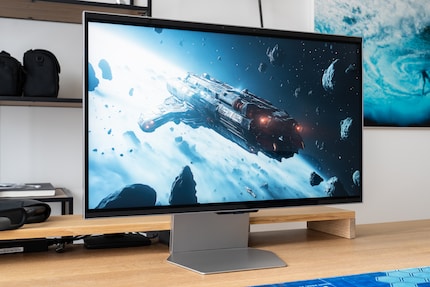
The 3D feature has to fix it
Samsung uses a 27-inch IPS panel with 4K resolution as the basis for the Odyssey 3D. Its picture quality in normal 2D mode is okay, but is nothing special given the high price. For this much money, you could also buy a very good OLED, which would be better in almost all respects. A comparable normal IPS monitor costs a fraction of the price. The entire value proposition of the device therefore rests on the 3D feature.
The specifications at a glance:
- Type: IPS panel, LED backlight without local dimming
- Format: 27 inch, 16:9
- Resolution: 3840 × 2160 pixels, 163 ppi pixel density
- Brightness: 350 nits
- Picture frequency: 165 Hertz
- Response time: 1 ms grey to grey
- Colour space coverage: 99 % sRGB
The casing is made of silver plastic. The workmanship and stability could be better, but this is not a major problem for this monitor size. Something else, however, is: My test model suffers from coil whine - not on the power supply unit but in the monitor itself. The noise varies depending on the picture content.
The built-in speakers are rather too quiet. I would only use them in an emergency due to the lack of bass. Although, to be fair, I have also heard much worse. There are two HDMI 2.1 ports, one DisplayPort 1.4 port and two USB-A ports. Unlike with other monitors, you have to connect the USB uplink here. This is because the eye tracking data transfer also runs via this.
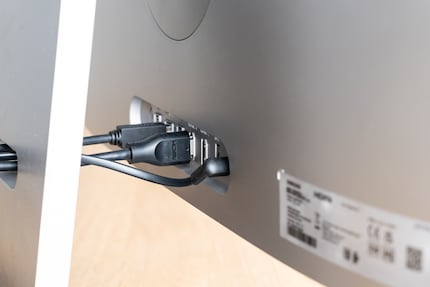
Samsung calls its 3D technology «Light Field Display» (LFD). It works according to the same principle of stereoscopy as other manufacturers - such as Acer's «Spatial Labs»: Cameras film the person in front of the monitor, which tracks the position of the eyes in real time.
The software calculates two different images for the specific eye distance. Thanks to the lenticular lenses, my left eye sees a different image to my right eye - and my brain puts it all together to create a spatial perception. Because the monitor displays two images simultaneously, the resolution is halved from 3840 × 2160 to 1920 × 2160 in 3D mode.
Excitement is followed by disillusionment
The 3D effect without glasses initially creates a wow effect. The display of optimised content looks good at first glance. My character in the game «The First Berserker: Khazan» moves in the foreground, while the game world recedes into the background. In 3D films, objects fly around my ears - I remember that from 3D cinema.
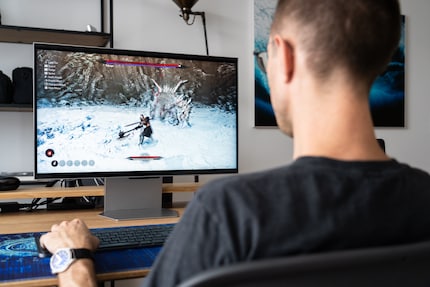
Samsung deserves credit for the fact that everything works very smoothly. The software «Odyssey 3D Hub» recognises 3D-capable content and also acts as a launcher for compatible games. Apart from installing the tool, no further steps are necessary. I don't have to calibrate the monitor to my eyes or sit in a certain position. As long as the presence of several people doesn't confuse the eye tracking, it works reliably.
However, my initial enthusiasm dwindles the longer I use the Odyssey 3D. The three-dimensional display is choking on details: fonts and menus have a drop shadow in many cases, which looks terrible. Display reflections from the real world also break the 3D illusion and are extremely irritating. As the IPS panel, together with the mirrored surface, is relatively susceptible to reflections, I have to darken my room considerably.
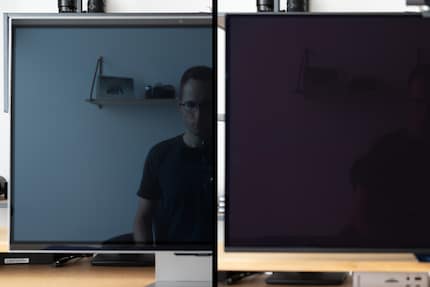
The 3D calculation itself is also not beyond reproach. Sometimes my brain can't tell whether an object is behind or in front of another plane. This is particularly bad in scenes with fast movements. When the space station is hit by space debris in the film «Gravity», I have to close my eyes in sheer confusion. I can only spend an hour at most in 3D mode. After that, I either feel sick or get a headache.
The reason becomes clear to me when I analyse the image in the game «Stray» more closely: I can see a transparent ghost version of my protagonist cat to the left and right. This effect means that I have to constantly refocus my eyes. It feels a bit like when you're looking at a picture of «The Magic Eye» and never quite get the focus right. Text overlays are also on a different spatial plane than the character. At such moments, I either see my cat or the text twice.

Samsung's flagship game «The First Berserker: Khazan» seems to be more cleanly optimised. I see fewer ghost images here - but there are still some. Just like all the other content I was able to try out. I have no idea whether this is a teething problem or a limitation of the technology. Depending on the image content, the ghosting effects are more or less noticeable. Overall, however, the 3D feature simply doesn't seem mature enough for me to use it voluntarily.
Little content, Samsung helps out
Only very little content is available in 3D. There are clips on YouTube, but they are few and far between and mostly of poor quality. None of the major streaming services offer real films or series in 3D. So you would have to dig out Blu-ray discs or rips from the heyday of 3D cinema. But let's be honest: who does that at their desk on 27 inches?
What remains are compatible games. There are three of these for the launch of the Odyssey 3D, which have been ported in direct collaboration with Samsung: «The First Berserker: Khazan», «Lies of P» and «Wuthering Waves». Further titles are to be added in the future, including «Stellar Blade» (July 2025), «Black Myth: Wukong» (August 2025) and «Cyberpunk 2077» (January 2026). The 3D hub software also supports other games for which Samsung does not promise an optimal experience. I would clearly confirm the latter in the case of «Stray», for example.
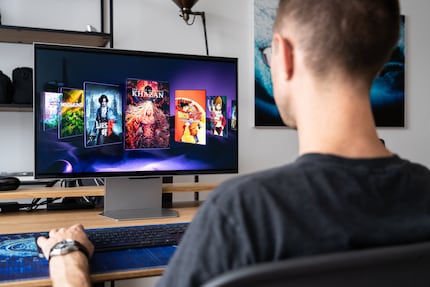
The game developers of well-known titles are probably not making the 3D versions of their own accord. I assume that Samsung is paying them - which I think is a good thing. If a manufacturer is already bringing 3D out of obscurity, it needs such investments. However, they will only be there as a start-up aid. In the medium term, the technology should reach a broad mass so that studios optimise their games on their own initiative. Will that happen? I highly doubt it.
In addition to native 3D, AI algorithms should also be able to convert 2D content. However, this only works with an Nvidia graphics card. As my PC has an AMD card, I was unable to test this feature. However, given the already shaky experience with real 3D games, my expectations are rather low.
In a nutshell
At best something for absolute 3D enthusiasts
Basically, I think it's nice that Samsung is trying something new. The Odyssey 3D actually creates the illusion of depth without me having to wear special glasses or configure anything. The 3D hub software also works according to the plug-and-play principle and makes it easy to get started. In purely technical terms, the South Koreans are doing a lot of things right here.
However, the monitor is not a market-ready product. Firstly, there is very little content: Samsung does invest in collaborations with game developers. However, only very few games are really well optimised for the Odyssey 3D. Even if there are a few more, the variety remains as small as the added value of the 3D effect. Secondly, image artefacts occur even in the flagship games. This is extremely tiring for the eyes and I can't stand it for long.
Once you get used to the 3D effect, it's nothing special any more. Then I only notice the reduced picture quality: sub-optimal black levels, halved resolution, not so great response time. And in 2D mode, the Odyssey 3D is simply a mediocre and far too expensive gaming monitor. I can therefore only advise against a purchase.
Pro
- 3D effect without glasses
- Plug and play
- Solid 2D picture quality
Contra
- exhausting 3D experience
- too many image artefacts
- 3D mode reduces image quality
- 3D content is rare
- too expensive as a 2D monitor

My fingerprint often changes so drastically that my MacBook doesn't recognise it anymore. The reason? If I'm not clinging to a monitor or camera, I'm probably clinging to a rockface by the tips of my fingers.



